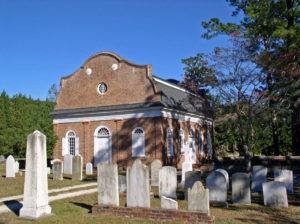We spied this sculpture recently somewhere in Charleston County. It might be a little tough to identify, but if you can, where is it? For bonus points, what in the world is it? Send your guess to editor@charlestoncurrents.com. And don’t forget to include your name and the town in which you live.
Our previous Mystery Photo
Our July 15 mystery, “Old brick church,” showed St. Stephen’s Episcopal Church in Berkeley County’s appropriately named St. Stephen, S.C. (Which came first, the church or the town?)
Thanks to Bill Segars of Hartsville for providing the great photo of the Georgian church, first built in 1767. And congratulations to these sleuths who figured out the mystery: Chris Brooks of Mount Pleasant; George Graf of Palmyra, Va.; Reginald G. Mixon of Moncks Corner; Stephen Yetman, now of Savannah; Marnie Huger of Richmond, Va.; Jay Altman of Columbia; and Evan D. Cook of James Island.
Extra kudos to Graf, Mixon and Huger for guessing on the construction cost, which Segars said was 1,000 pounds sterling. Graf guessed 1,600 pounds sterling, compared to Mixon’s $1,500 and Huger’s 4,000 pounds sterling.
We enjoyed this from Huger: “The church was originally built of wood in 1754, but the brick structure was started in 1767. It’s a small Georgian country chapel, and only one of 125 colonial Episcopal churches still in use in the U.S. According to parish records it was made of 150,000 bricks made and supplied by Charles Cantey, although the National Register credits Francis Villepontoux and A. Howard for supplying them.
“I really don’t know the cost, but I’m going to guess it cost about 4,000 pounds sterling in 1767 since I think that’s about what Punkin Hill [also known as Pompion HIll] cost. 1,000 pounds in 1767 = $164,915 today, so 4,000 pounds would be around $660,000 in today’s money.”
Graf provided this additional context: The famous Dr. Francis Peyre Porcher, MD, LLD was buried here in 1895. He was a well-known herbalist and leader in the CSA medical corps. He was assigned by the Surgeon General of the Confederate Medical corps (Dr. Sam P. Moore) to pen a book on regional herbs and plants for the Confederacy to utilize as the blockade during the Civil War by the North was hurting efforts to supply needed medication for the Southern effort. He went on to do great things post-war as well. MUSC (teaching hospital in Charleston, SC) has a living memorial garden to Dr. Porcher.”
- Send us a mystery: If you have a photo that you believe will stump readers, send it along (but make sure to tell us what it is because it may stump us too!) Send it along to editor@charlestoncurrents.com.





 We Can Do Better, South Carolina!
We Can Do Better, South Carolina!

























One Comment